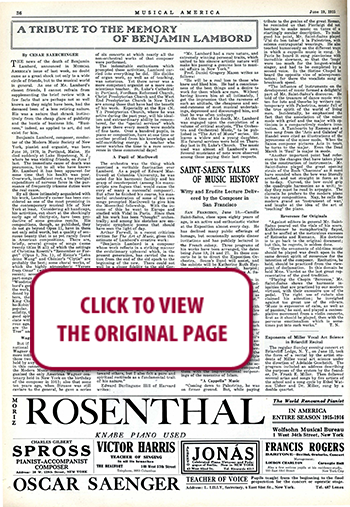 100 YEARS AGO...IN MUSICAL AMERICA (99)
100 YEARS AGO...IN MUSICAL AMERICA (99)
June 19, 1915
Page 36
SAINT-SAËNS TALKS OF MUSIC HISTORY
Witty and Erudite Lecture Delivered by the Composer in San Francisco
SAN FRANCISCO, June 10.—Camille Saint-Saëns, close upon eighty years of age, is an active and enthusiastic visitor at the Exposition almost every day. He has declined many public offerings of homage, but occasionally accepts dinner invitations and has publicly lectured in the French colony. Three programs of his works have been arranged, the dates being June 19, 24 and 27. In these concerts he is to direct the Exposition Orchestra. Sousa’s Band will assist, and the soloists will be Katherine Ruth Heyman, pianist; Ada Sassoli, harpist; Horace Britt, ‘cellist, and Wallace A. Sabin, organist.
The Saint-Saëns lecture was given in the French Pavilion on Tuesday. Redfern Mason in his Examiner account of it says the venerable composer “talked, played the piano and sang recitative as it should be sung, and as it should not.” Mr. Mason continues:
“Saint-Saens talked about music with that erudition, urbanity and sly malice that characterize the man in his published works. “He began by talking about the neumes and diaphony, remarking with a touch of irony that, before the thirteenth century, music was a ‘grimoire,’ which, if my memory serves me right, is a ‘devil’s grammar,’ a volume beloved of astrologers and witches. He glanced at the superstition, based on the undecipherableness of manuscripts, that all the songs of the trouvères were in triple time. He also touched on the Oriental origin of many of the melodies of the ecclesiastical plain-chant and compared them with the improvisational outpourings of the muezzins of Islam.
“A Cappella” Music
“Coming down to Palestrina, he was on firmer ground. But, while paying tribute to the genius of the great Roman, he reminded us that Pierluigi did not hesitate to make music on tunes of a startingly secular description. To make good his point, Mr. Saint-Saëns played ‘J'ai du bon tabac’ à Ia Palestrina, with solemn contrapuntal weavings. He also touched humorously on the different ways in which a cappella music is sung. In Paris he heard it sung pianissimo with incredible slowness, so that the ‘longs’ were too much for the longest-winded singer, and had to be completed by a second voice. In the Sistine Chapel he heard the opposite vice of misrepresentation; for there the vocalists sang at breakneck speed.
“The influence of instruments on the development of music formed a delightful part of Mr. Saint-Saëns’s discourse. He told of the treasure of dance music written for lute and theorbo by writers contemporary with Palestrina, music full of the true spirit of the world of living men. Incidentally, he emphasized the fact that the association of the minor mode with grief and the major with optimism is a comparatively modern innovation. A Tambourin by Rameau and a love song from the ‘Acis and Galatea’ of Handel were cited as illustrations of the joyousness of the minor mode. When the Saxon composer pictures Acis in tears, he turns to the major. Even the Dead March in ‘Saul’ is major in mode.
“Another important point 'had reference to the changes that have taken place in the construction of instruments. Mr. Saint-Saëns played the great opening strain of the Bach ‘Chaconne’ as it must have sounded when the bow was literally arched, and not straight in form as it is to-day. Curved, the bow could grip the quadruple harmonies as a unit; today they must be read in arpeggio. The clavecin he prefers to the modern piano in many compositions. Nay, he calls the modern grand an ‘instrument of war,’ and laughs at the idea of the art of ‘touching’ the piano.
Reverence for Originals
“Against editors in general Mr. Saint-Saëns poured out the vials of his scorn. Kalkbrenner he metaphorically flayed, and he scoffed at the meticulous excesses of Reinecke and Riemann. His doctrine is to go back to the original document; but this, he regrets, is seldom done.
“How the ornaments of old-time music should be played was dwelt upon in the same devout spirit of reverence for the intention of the composer. Recitative, he held, should be practiced from the viewpoint of declamation. In this domain he held Mme. Viardot as the last great representative of the good tradition.
“Playing the Chopin ‘Berceuse,’ Mr. Saint-Saëns shows the harmonic iniquities that are practiced by our modern virtuosi, with their excessive use of the pedal. The right use of rubato also claimed his attention; he inveighed against too great use of the vibrato. ‘Music is expressive of calm, as well as of passion,’ he said, and played a contemplative movement from a violin concerto, first as it should be played, then with the perverse emotionalism which is sometimes put into such works.” —T. N.




 RENT A PHOTO
RENT A PHOTO





